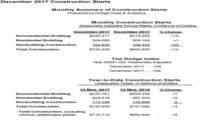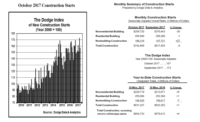The value of new construction starts in July advanced 6 percent from the previous month to a seasonally adjusted annual rate of $728.1 billion according to Dodge Data & Analytics. Leading the way was a 26 percent jump by the non-building construction sector, which reflected an improved level for public works and the start of two massive power plants, located in California and New York, respectively. Residential building in July increased 8 percent, as multifamily housing rebounded after three consecutive monthly declines. Running counter was a 7 percent slide for non-residential building following its 14 percent hike in June, as both office buildings and hotels retreated from June’s elevated activity, outweighing a sharp rise for healthcare facilities in July. During the first seven months of 2017, total construction starts on an unadjusted basis were $411.9 billion; down 1 percent from the same period a year ago. Even with the two massive power plants reported as July starts, dampening the year-to-date performance for total construction was a steep 44 percent decline for the electric utility/gas plant category. If the electric utility/gas plant category were excluded, the total construction starts in this year’s January-July period would be up 3 percent from a year ago.
July’s data lifted the Dodge Index to 154 (2000=100), compared to an upwardly revised 145 for June. After this year’s strong first quarter, the Dodge Index receded 11 percent in the second quarter. July’s total construction gain brings activity back to within 2 percent of the first quarter’s pace. “July’s increase means the third quarter began on a healthy note, which should help to maintain the up-and-down pattern on a quarterly basis that’s been present for construction starts over the past year,” stated Robert A. Murray, chief economist for Dodge Data & Analytics. “Within that up-and-down pattern remains a modest upward trend, as it appears that construction starts are still in the process of reaching a peak, as opposed to having already reached a peak. Public works construction, after sluggish activity earlier in the year, is showing hesitant signs of improvement. It’s true that residential building is now seeing generally decreased activity for multifamily housing, but the monthly declines continue to be mixed in with monthly gains, such as what took place in July. For non-residential building, growth is being supported by its institutional segment, while commercial building is leveling off due to varied behavior by its individual project types.”
Non-building construction
In July, non-building construction was $195.8 billion (annual rate), up 26 percent from June and achieving its second highest amount so far in 2017 after February. The public works categories as a group rose 12 percent, rebounding after a 7 percent decline in June. Water supply construction had a particularly strong month; soaring 136 percent with the lift coming from the start of the $844 million Vista Ridge water supply pipeline project in San Antonio, as well as an $88 million recycled water treatment facility in San Francisco. Sewer construction improved 37 percent after a weak June, although river/harbor development receded 2 percent. Highway and bridge construction increased 10 percent in July, and featured the start of the $322 million I-74 bridge replacement across the Mississippi River in Davenport, Iowa, a $192 million highway expansion in San Antonio, and a $94 million rehabilitation project on the Henry Hudson Parkway in New York, N.Y. Through the first seven months of 2017, the top five states in terms of the dollar amount for highway and bridge construction starts were – Texas, California, Florida, Pennsylvania and Ohio. The miscellaneous public works category, which includes natural gas pipelines and mass transit, slipped 10 percent in July, continuing to recede after very strong activity back in May. Even with its decline, miscellaneous public works still included the July start of the $1.5 billion Brownsville to Nueces natural gas pipeline in Texas and a $225 million rail transit project in Bellevue, Wash. The electric utility/gas plant category surged 64 percent in July, registering its second straight monthly gain in contrast to the substantially weaker activity reported during the first five months of 2017. Two massive natural gas-fired power generation facilities were included as construction starts in July – the $2.2 billon Carlsbad Energy Center in Carlsbad, Calif., and the $1.6 billion Cricket Valley Energy Center in Dover Plains, N.Y. Five other large power plant projects reached groundbreaking in July. These projects were located in Connecticut ($550 million), Georgia ($400 million), Minnesota ($300 million), Arkansas ($203 million) and Nebraska ($150 million).
Residential building
In July, Residential building was $301.1 billion (annual rate), up 8 percent. Multi-family housing increased 30 percent, strengthening after three monthly declines in a row. There were nine multi-family projects valued at $100 million or more that reached groundbreaking in July, led by the $360 million Wolf Point East apartment tower in Chicago, the $225 million multifamily portion of the $280 million mixed-use redevelopment of the Domino sugar factory in Brooklyn, N.Y., and a $225 million condominium tower in Honolulu. In July, the top five metropolitan areas in terms of the dollar amount of multifamily starts were – New York, N.Y., Chicago, Los Angeles, Boston and Atlanta. Through the first seven months of 2017, the top five metropolitan areas, with their percent change from a year ago, were – New York, N.Y., down 20 percent; Los Angeles, up 16 percent; Chicago, down 2 percent; San Francisco, up 27 percent; and Washington D.C., up 6 percent. Single family housing in July was flat with the previous month, not yet showing renewed growth after settling back 4 percent in the second quarter following its first quarter that had a 6 percent gain. By geography, single family housing in July performed as follows relative to June – the Northeast, up 3 percent; the South Central, up 2 percent; the South Atlantic, up 1 percent; the West, unchanged; and the Midwest, down 3 percent.
Non-residential building
In July, non-residential building was $231.2 billion (annual rate), down 7 percent. The commercial categories as a group dropped 22 percent, retreating after climbing 24 percent in June. Office construction in June surged 82 percent, boosted by the start of eight office projects valued at $100 million or more, led by a $585 million Facebook Data Center in Omaha, Neb., and the $400 million office portion of the $500 million renovation of the Willis Tower in Chicago. In July, office construction fell 52 percent with only one project valued at $100 million or more – the $118 million Wheaton Town Center in Wheaton, Md. A similar pattern was present for hotels, which surged 65 percent in June with the push coming from the start of the $575 million hotel portion of the $900 million Seminole Hard Rock Hotel and Casino expansion in Hollywood, Fla. In July, hotel construction fell 42 percent, with the largest project being the $78 million hotel portion of a $115 million hotel/apartment mixed-use project near the Seattle-Tacoma International Airport. On the plus side, warehouse construction jumped 46 percent in July, lifted by the start of a $144 million warehouse complex in Stockton, Calif., a $135 million Wal-Mart distribution center in Mobile, Ala., and a $100 million Amazon distribution center in Fresno, Calif. July gains were also reported for commercial garages, up 9 percent; and stores and shopping centers, up 7 percent. Manufacturing plant construction in July fell 29 percent from its June amount that included the start of a $1.8 billion methane plant in Louisiana. While down from June, manufacturing plant construction did see the start of several large projects in July, such as a $1.1 billion polyethylene plant expansion in Beaumont, Texas.
The institutional side of the nonresidential building market climbed 16 percent in July, in contrast to the declines reported for the commercial and manufacturing segments. Healthcare facilities jumped 108 percent after a weak June, led by groundbreaking for the $1.5 billion Penn Medicine Patient Pavilion in Philadelphia, Pa. Other large healthcare facility projects that started in July were the following – the $349 million Inspira Medical Center in Glassboro, N.J., the $125 million Bristal Jericho assisted living facility in Oyster Bay, N.Y., a $110 million hospital expansion in Bethesda, Md., and a $105 million ambulatory care complex at the University of Utah in Salt Lake City. Transportation terminal construction also posted a large percentage increase after a weak June, rising 85 percent with the help of a $121 million aircraft maintenance facility at Tinker Air Force Base in Oklahoma City. The religious building category, while still at a very low level, increased 24 percent in July. On the negative side, educational facilities slipped 3 percent in July, although the category did include the start of several large school construction projects, including a $104 million high school renovation in Cleburne, Texas, a $104 million high school in Buda, Texas, a $96 million public school complex in Willoughby, Ohio, and a $91 million high school in Stoughton, Mass. Through the first seven months of 2017, the top five states in terms of the dollar amount of educational facility construction were – Texas, New York, California, Washington and Massachusetts. July declines were also registered by public buildings (courthouses and detention centers), down 13 percent; and amusement-related work, down 32 percent.
The 1 percent slippage for total construction starts on an unadjusted basis during the January-July period of 2017 was due to diminished activity for non-building construction, as both residential building and non-residential building managed to post gains. Non-building construction dropped 15 percent year-to-date, with electric utilities/gas plants down 44 percent and public works down 2 percent. Residential building year-to-date was up 1 percent, with a 9 percent increase for single family housing slightly outweighing a 14 percent slide for multifamily housing. Non-residential building year-to-date climbed 8 percent, with institutional building up 12 percent while commercial building held steady, combined with a 27 percent increase for manufacturing building that marks a shift from this category’s sharp declines in 2015 and 2016. By geography, total construction starts during the January-July period showed this pattern relative to a year ago – the South Atlantic, up 8 percent; the Northeast, up 6 percent; the West, up 2 percent; the South Central, down 7 percent; and the Midwest, down 14 percent. The 7 percent year-to-date decline in the South Central reflected, in part, the comparison to the first seven months of 2016 that included $6.2 billion for two liquefied natural gas terminals, while the 14 percent year-to-date decline in the Midwest reflected in part the comparison to the first seven months of 2016 that included the $3.8 billion Dakota Access pipeline.





Report Abusive Comment